#Order: Phasmatodea
Text

We’re on an Insect roll at the moment, and here is probably one of the coolest bugs I’ve ever seen: The Spiny Leaf Insect! They are also known as Australian Walking Sticks and are a species of Phasmatids.
Honestly, Spiny Leaf Insect sounds more like a general description than an actual name-
#Phylum: Arthropoda#Class: Insecta#Order: Phasmatodea#Family: Phasmatidae#Subfamily: Extatosomatinae#Genus: Extatosoma#Extatosoma tiaratum#Australian walking sticks#Spiny leaf insects#Walking sticks#leaf insects#Phasmatids#insects
0 notes
Text
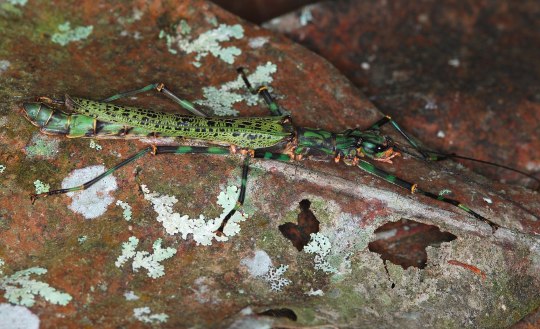
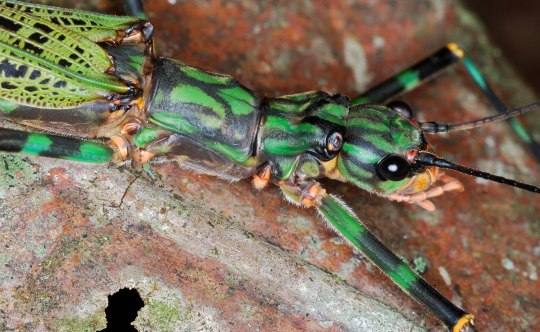
Stick Insect (Orthomeria pandora), family Aschiphasmatidae, order Phasmatodea, Tapah Hills, Perak, Malaysia
photographs by Bernard DUPONT
607 notes
·
View notes
Text
Taxonomy Tournament: Insects


Phasmatodea. This order is made up of insects that mimic plants. Members include stick insects and leaf-bugs
Orthoptera. This order has elongated hindlegs adapted for jumping. Members include grasshoppers, crickets, and katydids.
#animals#biology#polls#poll tournament#zoology#stick insects#leaf bugs#arthropods#insects#ecdytes#grasshoppers#crickets#katydids#Phasmatodea#Orthoptera#0x42v0xbd#animal tournament#Animal Tournament Round 1
414 notes
·
View notes
Text









INSULINDIAN PHASMID / IRL PHASMIDS (PHASMATODEA ORDER INSECTS, COMMONLY KNOWN AS STICK BUGS). first screenshot refers to a specific family of phasmids, the rest pertain to the order at large. this isnt like deep research obviously Im Not an entomologist in the slightest But ! :D
#disco elysium#insulindian phasmid#i may not blog about her often but she will always be in my heart#but anyways yeah heres yalls confirmation that ''get stickbugged'' memes are EXTREMELY accurate for her. in case u needed that
170 notes
·
View notes
Note
Mantises are an order (Mantodea) of insects that contains over 2,400 species in about 460 genera in 33 families. The largest family is the Mantidae ("mantids"). Mantises are distributed worldwide in temperate and tropical habitats. They have triangular heads with bulging eyes supported on flexible necks. Their elongated bodies may or may not have wings, but all Mantodea have forelegs that are greatly enlarged and adapted for catching and gripping prey; their upright posture, while remaining stationary with forearms folded, has led to the common name praying mantis.
The closest relatives of mantises are termites and cockroaches (Blattodea), which are all within the superorder Dictyoptera. Mantises are sometimes confused with stick insects (Phasmatodea), other elongated insects such as grasshoppers (Orthoptera), or other more distantly related insects with raptorial forelegs such as mantisflies (Mantispidae). Mantises are mostly ambush predators, but a few ground-dwelling species are found actively pursuing their prey. They normally live for about a year. In cooler climates, the adults lay eggs in autumn, then die. The eggs are protected by their hard capsules and hatch in the spring. Females sometimes practice sexual cannibalism, eating their mates after copulation.
Mantises were considered to have supernatural powers by early civilizations, including ancient Greece, ancient Egypt, and Assyria. A cultural trope popular in cartoonsimagines the female mantis as a femme fatale. Mantises are among the insects most commonly kept as pets.
I love annoying you :)
Have a great day mantis-hater
Oh fuck you @eyedrinktwomp I'm gonna go kill a mantis cuz of this
7 notes
·
View notes
Text
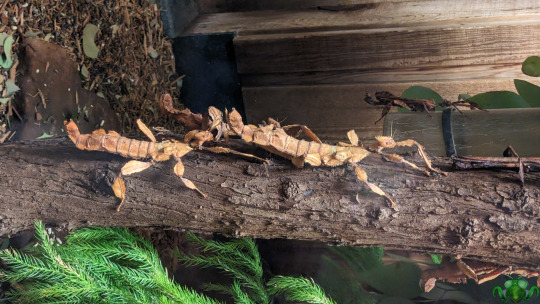
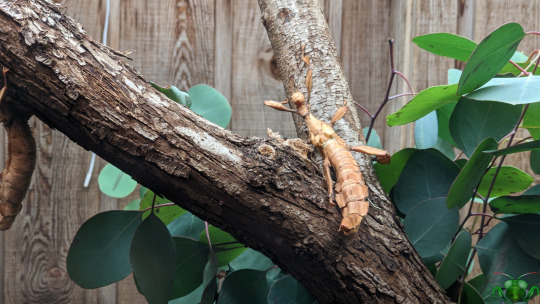
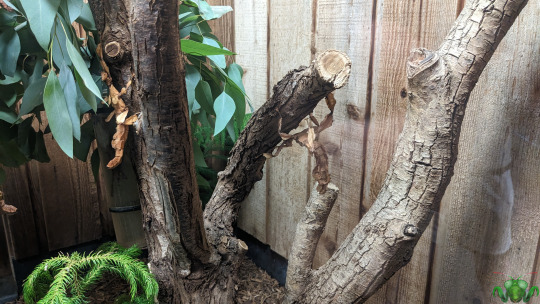
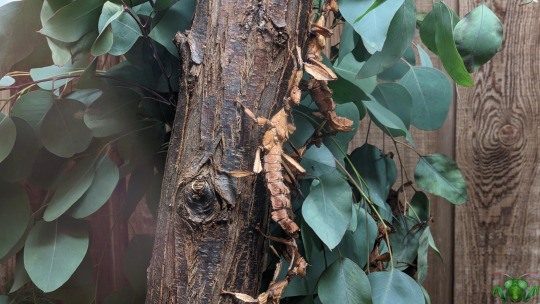
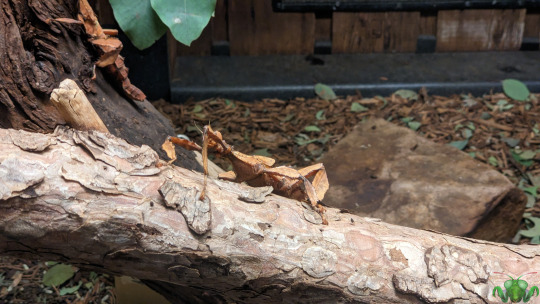
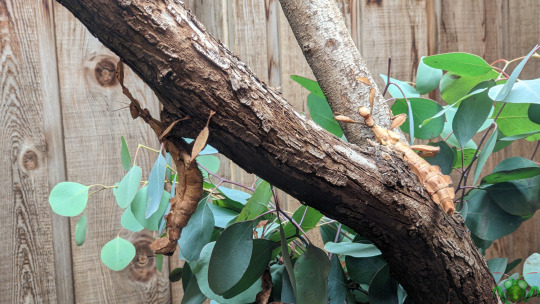



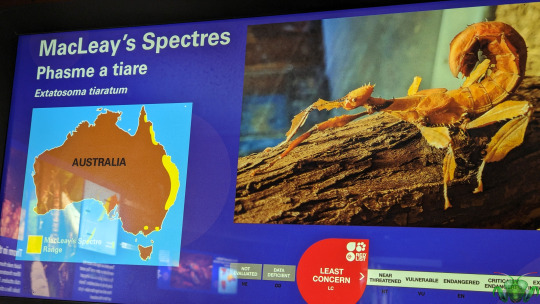
Spiny Leaf Insect - Extatosoma tiaratum
It's been many years since I've laid my eyes on one of these magnificent creatures, and even longer since my days at UofT where I held one in my hand. As such, it was gratifying to see so many individuals on display at the Toronto Zoo and to soak in all their details and movements (mostly wobbles and slow, methodical steps) while observing them. With many female individuals, and a few different instars among them, I should have taken a video, but there was lots of exciting screaming in the background from the otters and reptiles. As much as I love animals, this blog is all about the insects, and so today we have pictures of these Giant Prickly Stick Insects. Today, they are known by many names such as Australian Walking Sticks, Spiny Leaf Insects, Macleay’s Spectres (named for British entomologist William Macleay and referencing their order Phasmatodea, whose name is derived form apparitions or more commonly, ghosts) or E. tiaratum. What ever you call them, just don't call them "Leaf Insects". Those are a different branch of Phasmid, of the family Phylliidae. Amazing as the former are, these large armored insects also have a certain special quality to them. Maybe it's just how large and unusual they are compared to our fauna, but I certainly think that they're eye-catching when they can actually be found and observed. In the wild, finding them is far more difficult since their mottled, spiked, dried-in-appearance leafy armor is meant to hide them from their predators.
These peaceful, plant-eating giants need every advantage they can secure since they aren't aggressive and are burdened with slow movement due to their armor. In most cases, if anything gets close, the "scorpion" posture combined with a mild chemical defense and their sharp spines may be just enough. But what if you're a thinner, more agile male? If you've been observant, there is one such darker individual in the background of Picture 1! They're quite different in appearance from females, being much smaller and slimmer, and they are also quite rare! Moreover, a mild reliance on using parthenogenesis to reproduce and lay eggs, they can become even rarer! The thin male has functioning wings and can use them when in danger by either flying away or flashing them to a predator, startling them. Naturally, wings also allow for a wider dispersal and an expansion to the search for fertile females. In an environment within captivity, the presence of a male may be likely to discourage parthenogenesis and in fertilized eggs that will hatch earlier after females drop them to the soil floor. There were no eggs to be found, so if you plan to visit and search for them, look for brown and white, seed-like objects fitted with a capsule-like projection (capitulum). They are likely to be removed and stored, as the eggs of E. tiaratum are reported to need cooler conditions to successfully hatch. Their terrarium may simulate a warm, tropical environment too well in that case. In the wild, Ants fulfill this condition, bringing the "seeds" underground into their food stockpile.
These insects are exhibited in the Toronto Zoo, so I’ve marked them with the Mantis icon. Pictures were taken August 27, 2023 at the Toronto Zoo with a Google Pixel 4. Please go and visit the animals (insects very much included).
#jonny’s insect catalogue#ontario insect#stick insect#spiny leaf insect#macleay's spectre#phasmatodea#phasmid#insect#toronto#toronto zoo#august2023#2023#nature#entomology#invertebrates
10 notes
·
View notes
Text
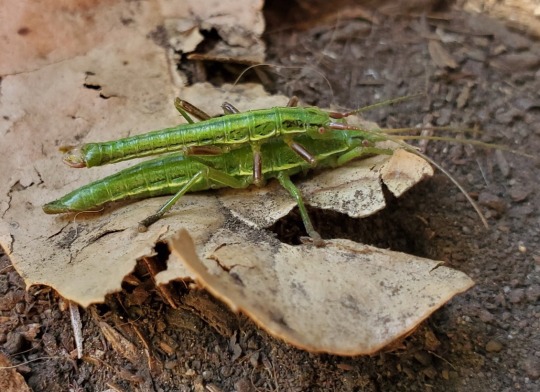

California timema (Timema californicum) in the Santa Cruz Mountains.
Timemas are a type of walking stick found mainly in California but also parts of Nevada, Arizona, Oregon, and Northern Mexico. They form a very ancient lineage of stick insects (order Phasmatodea) and thus have many characteristics that differ from the rest of the order. However, like all other phasmids, they are herbivores and rely on their camouflage to evade predation.
After mating, the male will ride on the female's back and "guard" her for up to 5 days. This is what's going on in the first picture.
Several timema species (but not this one) are parthenogenetic, meaning they only reproduce asexually and are almost entirely female (some species do rarely produce males and no one knows why). Two species have not reproduced sexually for over 1 million years, the longest of any insect!
#timema#california timema#timema californicum#phasmatodea#phasmids#walking stick#stick insect#bugs#nature#nature photography#biodiversity#animals#inaturalist#arthropods#entomology#insect appreciation#insects#parthenogenesis#science facts#nature is weird#bugblr#invertebrates#mount madonna#santa cruz mountains#california#santa cruz#educational#interesting
9 notes
·
View notes
Text
The creative variation of stick insect egg cases.
Female stick bugs lay eggs in small groups, or one at a time, on random leaves, or simply dropping them on the forest floor. The eggs are little works of art, tiny sculpted vases, when the nymph emerges it will unfold to be much longer than the egg. (Photos by François Tetaert)

FIGURE 3 | Stick and leaf insect eggs illustrating the breadth of their phenotypic diversity. Eggs depicted in the top two rows have capitula. Corresponding taxonomic
names are provided in Supplementary Table S3. Photos by François Tetaert.
Photo from: Evolution of Oviposition Techniques in Stick and Leaf Insects (Phasmatodea) James A. Robertson Sven Bradler and Michael F. Whiting.
Ants sometimes play a role in the dispersal of stick insect eggs (lol did you think there would be no ants in this story? LMAO. Come on.) basically the stick insect uses the same strategy as many plants. They don't just imitate the appearance of plants!
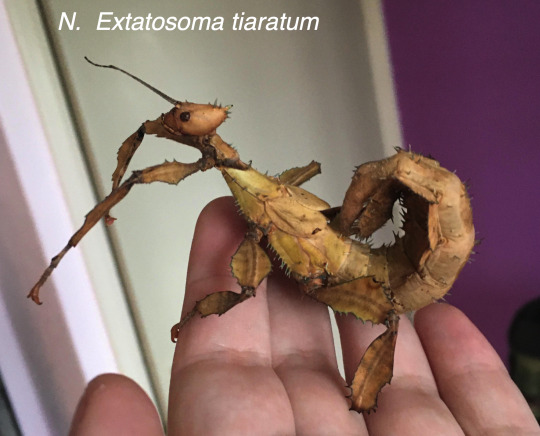
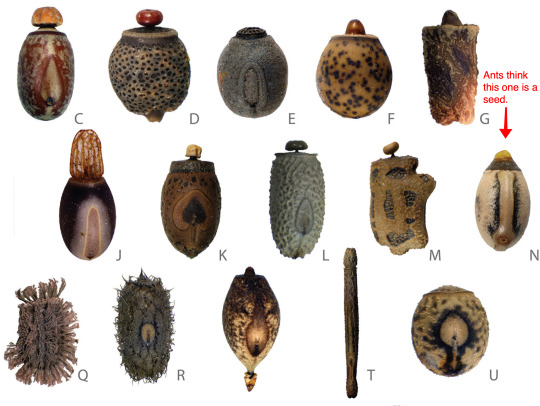
Photo of tiaratum via reddit.
The stick insect creates an egg/seed with a hard to remove edible reward, this causes ants to drag the eggs long distances. If you know ants are going to move your eggs for you... why not mimic ants too when you are too little to be mistaken for a plant?

The order containing stick insects is called Phasmatodea. What a remarkable bunch! There is a table showing their lineage and the many ways they disperse their eggs in this fantastic paper. Check it out! (free to download, lots of photos)
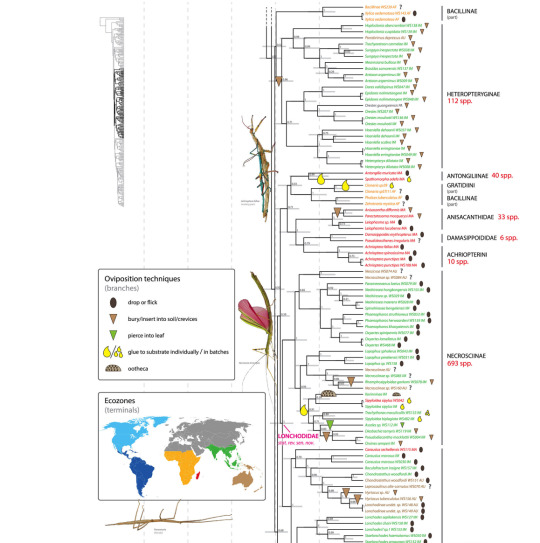
Last, here is the first photo again along with the scientific names for the species that created each egg case.

A Pharnacia ponderosa
B Dimorphodes sp.
C Eurycnema osiris
D Lonchodes malleti
E Cranidium gibbosum
F Paramenexenus laetus
G Melophasma antillarum
H Acrophylla wuelfingi
I Alienobostra brocki
J Bacteria horni
K Baculonistria alba
L Lonchodes dalawangsungay
M Lonchodes philippinicus
N Extatosoma tiaratum
O Asystata sp.
P Phyllium bioculatum
Q Phyllium mabantai
R Isagoras sp.
S Marmessoidea sp.
T Medaurini sp.
U Menexenus fruhstorferi
V TTisamenus serratorius
W Haaneilla erringtoniae
X Pylaemenes guangxiensis
Y Diapherodes martinicensis
Z Pijnackeria masettii
A’ Aretaon sp.
B’ Necrosciinae sp.
C’ Necroscia annulipes
D’ Parapachymorpha spinosa
E’ Orixines xiphias
F’ Neohirasea nana
G’ Xenophasmina sp.
H’ Pseudophasma subapterum
I’ Necrosciinae sp.

Lovely ultra-macro shot of the head of a female Extatosoma tiaratum from wikimedia commons.
#stick insect#invertebrates#bugs#bugblr#ants#antposting#stick bug#bug#i love bugs#antblr#bugcore#bugposting#entomology#insects#Phasmatodea#seed dispersal#science#ecology#biology#animals
49 notes
·
View notes
Text
#bug tw#insects#entomology#These order names all sound like over dramatic noble houses in a ya fantasy book.#Someone should make that.
13 notes
·
View notes
Text
Stickbugs are adorable and fascinating but I also love that their Order is called Phasmatodea, aka Phasmids. The name refers to their ability to seemingly vanish (by just being hella good at camouflage).
There's debate over whether to call them phasmatodeans or phasmids. I'm on the "phasmids" side because (1) it fits the naming conventions well enough, (2) it's easier to say and write which makes it more accessible, and (3) "phasmid" is cool as hell
also if you're gonna call em phasmatodeans you might as well go with phasmatodes because literally nematodes ain't called nematodeans like come on
#orcspeak#also stickbug eggs look like little pots#also the stealth skill in biology is called ''crypsis'' which is fuckin badass
11 notes
·
View notes
Text
nav // tag guide for app (pinned post)


I'm Clavain, a 26yo software/web dev who hates computers and wants to become moss. I live in the French Pyrénées and speak English/French. My other blog is Clavainova. This blog has (natural or fictional) animal death, taxidermy, horror and gore, so watch out for that if it upsets you. This is the tagging system, which is very consistent, and I will not take offense if you block all my original content:
For desktop tag guide go here: nav
Original content: #clavain art
Animals:
#birds (sorted by order) : #raptors (#strigiformes, #falconiformes, #accipitriformes, #swoop), #eurypygiformes, #pelecaniformes, #suliformes, #ciconiiformes, #gruiformes, #anseriformes, #charadriiformes, #columbiformes, #passeriformes (#goldfinches, #corvids > #pica), #caprimulgiformes
#mammals :
#carnivora (#canids > #sighthounds, #felids > (#tigers, #lions, #pumas, #domestic cats), #ursids, #mustelids),
#rodents (#lagomorphs, #murids),
#ungulates (#cervids, #equids > #unicorns, #suids, #bovids > #ovines)
#invertebrates (mostly sorted by order) :
#insects (#mantodea, #phasmatodea, #orthoptera, #hymenoptera, #odonata, #lepidoptera > #moths > (#sphingidae, #saturniidae), #coleoptera, #cicadoidea, #diptera),
#gastropods, #myriapods, #isopods, #cephalopods > #nautilus, #crustaceans, #arachnids, #medusoids
other : #aquatic (#fish > #sharks, #marine mammals), #reptiles > #snakes, #amphibians > #anura, #paleo
Objects of interest: #lighthouses, #mazes, #spirals, #haunted houses, #urban decay, #traps and snares, #wings, #angels, #reapers, #fungi, #eyes, #moon, #rainbows, #trees > #forests, #decay, #teeth, #endoskeletons
PART 2 HERE
2 notes
·
View notes
Text

Stick Insect (Orthomeria pandora), family Aschiphasmatidae, order Phasmatodea, Tapah Hills, Perak, Malaysia photographs by Bernard DUPONT
0 notes
Text
Taxonomy Tournament: Insects


Mantodea. This order is made up of mantises, elongated predators with enlarged forelegs adapted for catching prey.
Phasmatodea. This order is made up of insects that mimic plants. Members include stick insects and leaf-bugs
#animals#biology#polls#poll tournament#zoology#mantises#arthropods#insects#ecdytes#stick insects#leaf bugs#Mantodea#Phasmatodea#0x3dv0x42
84 notes
·
View notes
Text
Oouhh i thought the insulindian phasmid being from the supposed order "phantasmodea" was just a randomly made up word but the actual order that stickbugs come from is called phasmatodea. dastardly
56 notes
·
View notes
Text

The Living Forest
description
in this forest there are no trees, not in the traditional sense at least. it consists hundreds of thousands if not millions of small bugs primarily Cryptophyllium genus, and insects from the Phasmatodea order. though they have evolved to consume much more then just plants
The Spread
They usually wait for unwitting traveler be they sentient or not, to enter the forest and sleep. The forest will then send hundreds of insects to swarm the traveler to then eat and multiply and grow into a new tree around the corpse. though once the forest gets large enough word often gets out causing it to then go hunting looking for a new home this often takes 1 of 2 forms. A spreading into a preexisting forest to then consume the wildlife or B finding a settlement to then swarm and consume the inhabitants. This option if far less common and only really happens when their is no applicable forest withing travel distance. after descending apron the unfortunate people they will often leave to go search for more food and leave a few hundred behind to create their own forest
Extra
this was something i have been thinking about for a while now and only just decided to make into some actual lore. it is still incomplete and i do plan on adding more and changing it in the future but as of now it
0 notes
Text


Phasmatodea is really existing name an order of stick insects, wow
0 notes